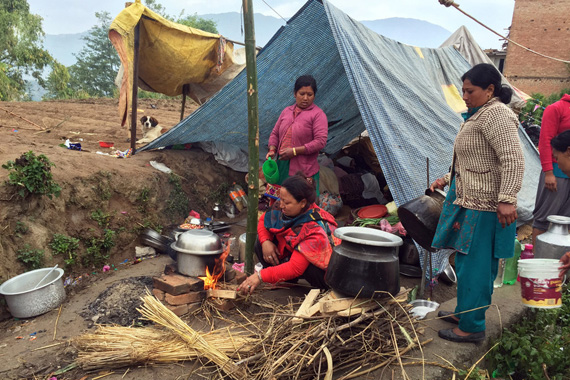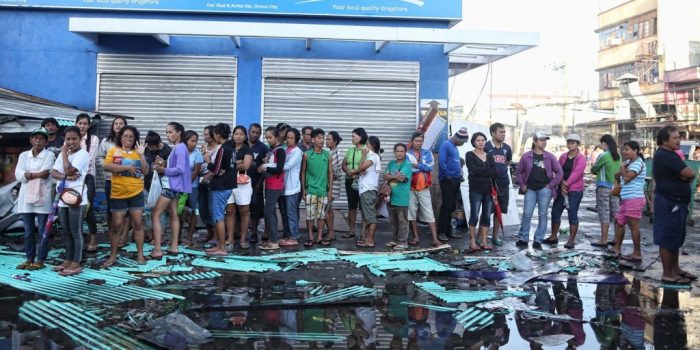Shelter – Now. Then. And Later.
The average American gets nine hours of sleep a night. Most of those average Americans sleep in a home, with a roof, a pillow, a mattress, and some sort of cover. But what does sleep look like for residents of Kathmandu? Just a few short days ago, a magnitude 7.8 earthquake struck the capital city […]

The average American gets nine hours of sleep a night. Most of those average Americans sleep in a home, with a roof, a pillow, a mattress, and some sort of cover. But what does sleep look like for residents of Kathmandu?
Just a few short days ago, a magnitude 7.8 earthquake struck the capital city of Nepal. More than 5,000 deaths have been confirmed (this figure is expected to rise dramatically), and upwards of 8 million Nepalese have been affected by this quake. Shelter is already presenting itself to be a serious problem, and based upon what we know to be true from other disasters, particularly earthquakes, will likely continue to be a struggle-laden issue area.

The Government of Nepal reports that over 70,000 homes have been destroyed. Given that relief efforts have not yet made it to more rural and remote villages, this figure is also expected to rise. As of 2011, the average household size in Nepal was 4.7 – that means that upwards of 329,000 individuals are completely homeless. Of the 8 million affected, 2.8 million are described as displaced from their homes, with many of those individuals are sleeping out of doors for fear that continued aftershocks will destroy their already-fragile residences. Furthermore, the affected region has been hit with what was described as “relentless rain” – meaning that people are in a precariously vulnerable position. And, relief efforts have just begun.
Shelter Now
The recently released UN Flash Appeal covering the time period from now until the end of July calls for $50,000,000 for shelter and non-food items as well as an additional $5,000,000 for camp management.
Shelter Then
Over the course of the next few weeks international nongovernmental organizations (iNGOs), the Government of Nepal, and multilateral organizations engaged in the shelter cluster (https://www.sheltercluster.org/) will distribute tents and build temporary / semi-permanent shelters for displaced persons. Once aftershocks subside, rubble will be cleared, and land will be prepared for rebuilding.
When thinking about shelter then, it is important to understand the climate of Nepal – it is a country that has brutal weather. With temperatures ranging from 110 degrees to cold, snowy winters, and rainfall in between – shelter will be of critical importance to quake-affected Nepalese. Joel Charny, vice-president of humanitarian policy and practice at InterAction, said to me “whatever shelter solution gets developed has to be a solid, resilience-based solution.”
Shelter Later
Charny indicated that the ‘ideal’ shelter solution at 18 months is to have all displaced persons back in a permanent shelter solution. In both the response to Katrina and Haiti, response fell far, far short of that goal. Either because of issues of land tenure, or of a semi-permanent solution that was semi-adequate, people displaced by Katrina and the Haiti earthquake were either displaced for five years or remain in semi-permanent solutions. Charny said that until we know the full scale of the damage and how many houses have been destroyed, it is difficult to estimate what the collective ability to return all residents to a permanent shelter within the utopian ideal. If there is availability of local labor and local materials, then the only obstacle would be financing.
The philanthropic community will need to be a part of rebuilding shelter – as part of restoring lives – for the foreseeable future. There are iNGOs that excel in this area. There are standards and approaches grounded in science, all which seek to bring normalcy back to a person’s life sooner rather than later. But, rebuilding shelter cannot and will not be successful without outside assistance. In closing, I’d like to share an excerpt from a report I read yesterday – Responding to Earthquakes 2008: Learning From Earthquake Relief and Recovery Operations. The report paints a compelling picture for the economic impacts of shelter and is worthy of setting to memory:
Seven Economic Impacts of Shelter
- Income increases faster for families provided with shelter than for others.
- Emergency shelter investment generates an economic payback conservatively valued at 3 to 8 times the value of the initial investment.
- Shelter has a positive economic return for the poorest and most vulnerable, even in the short term.
- Shelter benefits last well beyond the recovery period.
- Shelter benefits are larger after a year or two because of forward linkages.
- Shelter has a vital, but under-appreciated role as capital for development.
- Beyond capital, but lined to it, shelter also has an under-appreciated role as a platform for increasing incomes.
Sources for this blog include:
- Joel Charny, InterAction
- acaps.org
- UN Flash Appeal for Nepal
- Responding to earthquakes 2008: Learning from earthquake relief and recovery operations http://www.alnap.org/resource/5239.aspx
More like this
Nepal: Watch. Learn. Then Act

